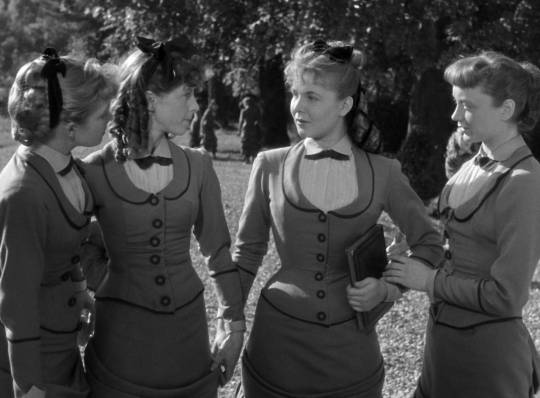#Suzanne Dehelly
Explore tagged Tumblr posts
Photo




Olivia (1951) Jacqueline Audry
May 13th 2023
#olivia#1951#jacqueline audry#marie-claire olivia#edwige feuillere#simone simon#suzanne dehelly#yvonne de bray#rina rhety#lesly meynard#marina de berg#tania soucault#the pit of loneliness
16 notes
·
View notes
Photo

- Tell me what it's like to be in love. - No, it's too horrible to talk about, too delightful to think about...
Olivia, Jacqueline Audry (1961)
#Jacqueline Audry#Colette Audry#Edwige Feuillère#Simone Simon#Marie Claire Olivia#Yvonne de Bray#Suzanne Dehelly#Marina de Berg#Lesly Meynard#Rina Rhéty#Tania Soucault#Elly Claus#Nadine Olivier#Christian Matras#Pierre Sancan#Marguerite Beaugé#1961#woman director
28 notes
·
View notes
Text
400 Words on OLIVIA [1951] ★★★

Originally published pseudonymously in 1949, Dorothy Bussy’s semi-autobiographical novel Olivia was a landmark work in mainstream lesbian fiction as well as a controversial one, taking place in a nineteenth century French boarding school where the schoolmarms and schoolgirls fell into and out of love with one another. The novel was adapted two years later by Jacqueline Audry into Olivia, a romantic melodrama that situates the erotic entanglements of its characters within the opulent world of high society privilege and anxiety. The film follows the amours of Olivia (Marie-Claire Olivia), a new student at a boarding school run by two rival headmistresses. The first, Miss Julie (Edwige Feuillère), reigns with the noblesse oblige of a monarch, doting on her favorites and inviting them to her chambers for evening readings from Jean Racine’s Andromaque and other classical tales of love won and love lost. The second, Miss Cara (Simone Simon), is a perpetually debilitated flirt with chronic migraines who holds court with a gossipy clique of students around her sickbed. Eventually Olivia falls into a love triangle with them both which threatens to transform into a love quadrangle with the sudden return of Miss Julie’s former favorite pupil Laura (Elly Norden). Handled differently, the material could’ve been adapted into a dark psychological thriller à la Alfred Hitchcock’s 1940 adaptation of Daphne du Maurier’s Rebecca (especially when it’s revealed that Miss Julie may or may not have been acting on predatory “impulses” with other students). And, indeed, there are moments where the set design borders on the expressionistic—as the film progresses Olivia’s bedroom seems to morph into a Miss Havisham cocoon with bed draperies hanging like so many spiderwebs. Additionally, cinematographer Christian Matras’ camerawork dips and weaves, pans and tracks like a less opulent imitation of Audry’s contemporary Max Ophüls. But Audry’s approach was primarily mannered—nearly suffocatingly so—occasionally bordering on the naturalistic. In this, it seems to borrow from Leontine Sagan’s Mädchen in Uniform (1931), a Weimar-era drama that was also about lesbian love in an all-girls boarding school. (Perhaps not incidentally—it’s reported that Sagan’s film left a great impression on Bussy and her work.) But Audry also attempts to keep the material from getting too dour with the injection of some rather odd comedic relief, chiefly in the form of the perpetually ravenous math teacher Miss Dubois (Suzanne Dehelly). Truthfully, it’s a welcome respite.
#★★★#Olivia#French Cinema#Film Reviews#1951#Dorothy Bussy#Jacqueline Audry#Marie-Claire Olivia#Edwige Feuillère#Elly Norden#Suzanne Dehelly#Simone Simon
15 notes
·
View notes
Photo

Jean Gabin & Suzanne Dehelly La nuit est mon royaume, Georges Lacombe (1951).
2 notes
·
View notes
Photo

Suzanne Dehelly pour la pièce Pas un mot à la reine mère d'Yves Mirande & Maurice Goudeket, au Théâtre Antoine en 1946.
#Suzanne Dehelly#Pas un mot à la reine mère#1946#1940s#Théâtre Antoine#Maurice Goudeket#Yves Mirande#théâtre#*
1 note
·
View note
Photo

Suzanne Dehelly, 1940.
2 notes
·
View notes
Photo

Suzanne Dehelly Cinq tulipes rouges, Jean Stelli (1949).
0 notes
Photo

Suzanne Dehelly La crise est finie, Robert Siodmak (1934).
0 notes